Waterproofing a bathroom under a tile: what is better to use under a tile
When repairing a bathroom, a waterproofing of the bathroom under the tile is necessarily carried out, which is best done with the help of a qualified specialist.
If this is not possible and the work is planned to be done independently, we recommend that you familiarize yourself with the requirements for moisture protection, materials and methods that are used for these purposes. We considered all these points in our article, and also brought the order of the work, focusing on the nuances of the preparation and application of each of the popular types of waterproofing.
The content of the article:
Basic requirements for waterproofing
Proper implementation of waterproofing allows you to protect the finish of floors, ceilings and walls from the damaging effects of moisture, prevents mold damage, provides protection against flooding of the rooms located below.
To waterproofing successfully cope with these tasks, it is necessary to ensure its compliance with certain requirements.
The main ones are the following:
- quick application will allow to form an integral coating and will not allow the occurrence of cracks and crevices;
- minimum intervals between application of layers - Each subsequent one should be laid immediately after the previous one has dried, which will ensure the best adhesion;
- compliance with the recommended overlap parameters when laying rolled sources with the conclusion of insulation on the walls when creating moisture protection of the floor.
In addition to the above, it is recommended to use a primer, which allows you to save on the number of sources and improve adhesion to the insulated surface. Before performing work, it is necessary to clean the surface as much as possible.A detailed briefing on the general waterproofing of the bathroom on our own we brought here.
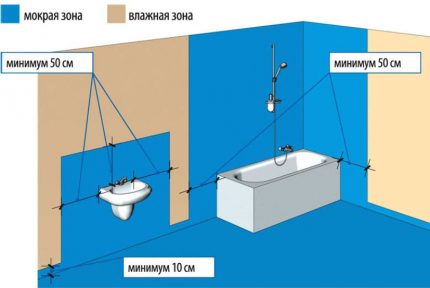
If it is not possible to completely isolate the bathroom, you can limit yourself to the areas most exposed to water and those most affected by moisture.
Types of moisture-proof materials for the bathroom
On the shelves of construction stores there is no shortage of special moisture-proofing agents. It will be difficult for an ignorant buyer to make a choice if they do not know their types and purpose.
Basically, the materials are divided into components that are used for their manufacture, structure, specificity of properties:
- masticapplied by coating surfaces;
- roll accessorieswhich are applied by pasting;
- pastes and liquid products;
- penetrating mixtureused for application on porous substrates.
In addition to the materials listed, for moisture protection of the bath, powder mixtures are suitable for creating waterproofing solutions by dilution.
With irregularities on the walls, you can use special plaster, in addition to resistance to wet environments, it will ensure smooth surface. Finally, for the same purposes, a film of polymers or rubber is often recommended, which is applied by spraying and forms a powerful barrier after drying.
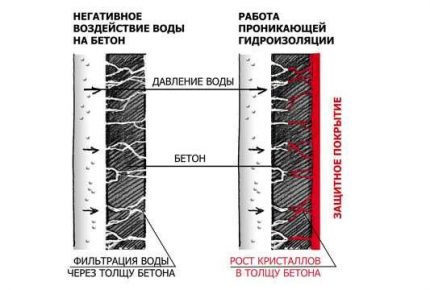
When choosing a suitable insulator, it is necessary to focus on the recommendations of the instruction, which usually indicates the scope of a particular tool. Choose materials recommended for use indoors.
Floor and wall tile barrier
Waterproofing of walls and floors can be performed by any composition, but has its own nuances. Walls usually do not require high level waterproofing. Paul, on the contrary, needs more thorough protection.
Optimal flooring materials
To protect the floor from the harmful effects of a wet environment, protective equipment is combined with a screed. Roll insulators are laid under it. They are easy to use - special adhesive strips are provided for fastening individual strips.
An alternative to them are coating mastics, which win in durability and efficiency. They are applied under the screed and on top of it, combine well with penetrating mixtures. The combination of such mastic, applied under the screed, with penetrating impregnation on top of it, can provide the most effective hydrobarrier.
Wall barrier options
Wall materials are easier to choose. To protect against moisture penetration, any of the formulations listed above can be used. If you plan to do it yourself, you should choose what is easiest to apply / use.
When the material factor is important, cost-saving will be provided by single-component mixtures that are diluted with water and are inexpensive. Two-component ones involve the use of polymer emulsions and are more expensive.
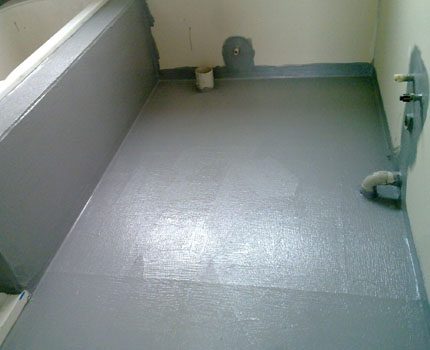
As with the floor under the tiles on the walls, it is usually recommended that the mixture is coated or impregnated, which are easily applied independently, and do not burden the budget with significant expenses.
Possible waterproofing methods
When working with any protective equipment, prior alignment of surfaces and their priming are often required. After drying the composition, you can proceed to the main work.If the insulation will be carried out independently, it is advisable to choose the most affordable technologies that do not require special equipment and special skills.
Method # 1 - applying coating paste
Such compositions are recommended for use in rooms that have a complex layout. They allow you to carefully process corners and ledges.
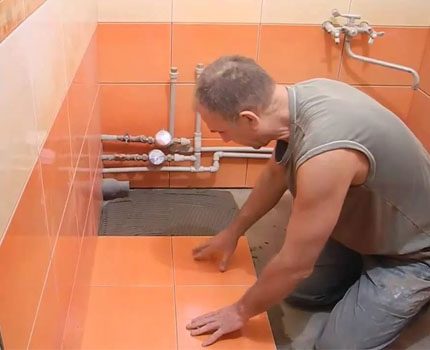
Among the most popular options usually distinguish polymer mixtures, polymer-cement and bitumen. They easily penetrate into the pores, isolate cracks, form an effective moisture barrier that does not crack for many years.
The advantage of such mixtures is ease of use:
- before application, the floor or walls are cleaned of dust and debris, if necessary they are leveled, moistened or treated with a primer, which increases adhesion;
- the dry mixture needs to be diluted with water with a temperature of at least room temperature in the ratio specified in the instructions;
- the composition is thoroughly mixed with water until smooth, let it brew for up to 5 minutes, then mix again and begin to apply.
Mastic is distributed on the surface in two layers immediately after the last mixing. After the first, the corners are glued with a special tape, which is carefully pressed into the insulation and straightened.
It prevents the penetration of wet environments, allows you to maintain a holistic barrier, which is especially important in the corners and at the joints.
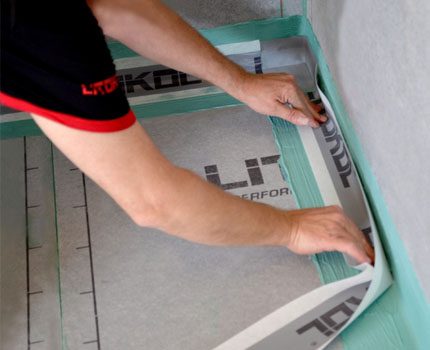
After completing the application of the first layer of insulation using this type of material, mesh reinforcement is performed and one more is laid on top, repeating the procedure from the beginning. It is important to completely close the previous layer.
Method # 2 - treatment with an impregnating composition
Impregnating compounds are called mixtures that penetrate deep into the structure, completely fill all cavities, strengthen, form a strong hydrobarrier, increasing the level of surface hydrophobicity.
It can be polymers, bituminous compositions, water glass and other options. As in the previous case, the base is cleaned and primed.
And then they perform the following actions:
- Dry compositions are diluted according to the manual per half an hour of work, after which the mixture dries and becomes unusable.
- After application and drying of the first layer, the base is reprocessed. To apply the mixture, you can use a roller or brush, depending on the consistency.
- When the work is finished, the surfaces give time to dry. Depending on the characteristics of the composition, this may take several days.
The entire drying period, the surface is recommended to be moistened periodically, which will ensure good crystallization of the insulating agent.
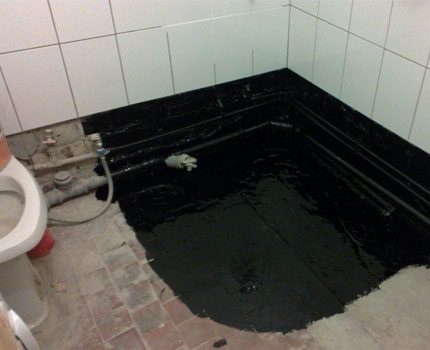
An additional advantage of any penetrating composition is the possibility of using it to restore the integrity of the old insulation, which has lost its original characteristics.
Method # 3 - the use of roll materials
In this case, you can use several options for roll tools. Fiberglass insulators are durable, insensitive to rot, but are expensive, require accuracy when laying, they are easy to damage.
Rolls made of roofing material or glassine are cheaper, but they become unusable faster.
Depending on the complexity and equipment used, three laying technologies are distinguished:
- fasteners - rolls are laid on the floor and fixed with special fasteners, which are then additionally insulated;
- heat gun - it creates a certain temperature regime necessary to deposit the applied coating;
- adhesive compounds or polymer-bitumen mixtures, the latter form additional protection against moisture.
Options with fasteners and the use of a heat gun are rarely used for waterproofing a bathroom.
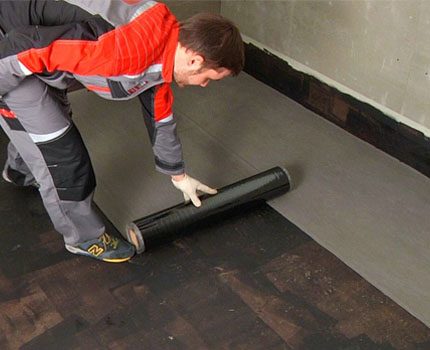
The best way is sticking, which is available to non-professionals and does not require special equipment. Before starting work, check whether surface alignment is required. If necessary, make a concrete screed. The joints are then rounded to help prevent cracking.
After standard cleaning, drying and priming, they begin to lay the material:
- rolls are cut into segments of the required length, rolled strips are treated with solar oil for greater elasticity and kept in this position for a day;
- the screed on top is treated with a coating or adhesive and overlap rolls are applied according to the manufacturer's recommendations;
- if bubbles arise, they are opened, the edges of the incision are treated with mastic and glued again, thoroughly smoothing.
At the meeting point of the wall with the floor, the rolls are bent and placed on the walls up to 15 cm, which ensures the reliability of waterproofing.
Method # 4 - applying waterproofing plaster
The option of creating a plaster moisture protection involves the use of polymer additives that increase the hydrophobicity of the base. The technology is almost no different from applying coating mixtures.
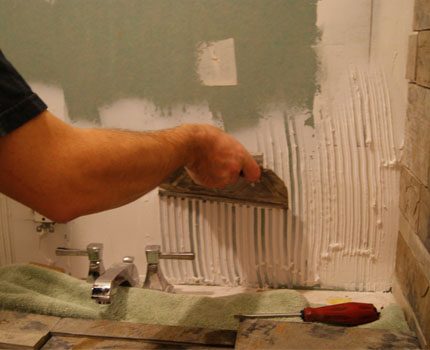
After necessary surface preparation, sealing tapes are glued at the corners and joints. Then the prepared solution is applied in 2-3 layers in different directions. For example, the first is vertically directed movements, the second is horizontal.
Features of waterproofing a wooden room
For a bathroom, the walls and floors of which are made of wood, it is impossible to apply all the options discussed above. Let's figure out how to properly implement moisture protection in such rooms.
How to protect wooden floors?
For a bathroom in wooden buildings, it is not recommended to use insulation with a concrete screed. It increases the load on the foundation and increases heat leakage. For this reason, the main way of arranging the floor is lag, which, if necessary, is insulated, observing the correct technology. Read about floor insulation on lags in this article.
Even at the planning stage of the house, flooring in the bathroom should be provided below the general level by about 10 centimeters. This will create the necessary barrier for water to enter other rooms in case of leakage.
One of the common options for isolating the field in this case is coating.
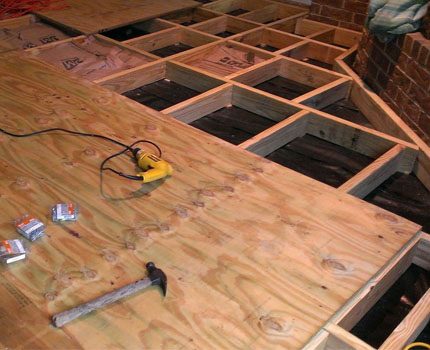
Before applying the mastic, preliminary preparation is required:
- all cracks, holes are sealed with special mastic for wood;
- the floor is thoroughly cleaned;
- treated with impregnation with antiseptic properties, which will prevent the occurrence of mold;
- the primer remains a mandatory preparation step, which improves adhesion to the insulator.
If necessary, alignment can be applied sheets with cement-bonded base, which are laid in two layers. When the preparation is finished, the floor is given time to dry, and they begin the main work.First of all, isolate all joints with a special tape.
Next, with the help of a roller, lay the first layer, use a spatula or brush in the corners. After it dries, which takes about 6 hours, impose a second layer strictly perpendicular to the first. During the day, the insulation is dried, then tiled work is performed.
Creating a barrier to wooden walls
As in the case of the floor, the walls must be pre-treated with an antiseptic, the existing cracks must be filled with mastic. The surface can be treated with wax, which protects the tree from deep penetration of moisture.
Then a double layer of primer is applied, increasing its density closer to the ceiling, where condensate usually accumulates. After drying, roll materials are laid or coated.
In the latter case, the work is performed as follows:
- prior to application, leveling of the surface is required, which is achieved with plaster on beacons using a level;
- corners are also insulated with tape;
- mastic is applied with a brush or spatula with a wide profile.
If it is planned to partially lay the tiles, the areas in the area of the sink, toilet and bathroom are coated with three layers of mastic. Each of them is applied after drying the previous one. The tiles are laid on completely dried insulation.
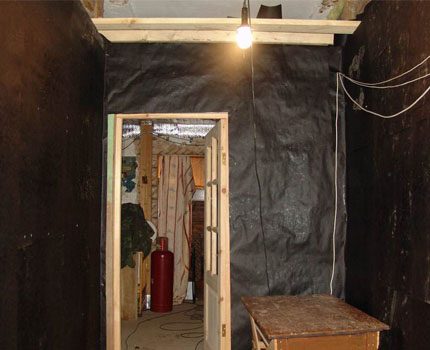
High-quality waterproofing materials, applied correctly, will provide reliable protection of walls and floors from moisture. But to achieve maximum results, it is equally important to apply reliable sealants when installing plumbing, carefully sealing all joints.
Conclusions and useful video on the topic
Video about the stages of creating a moisture barrier in the bathroom with recommendations and explanations:
Video about the features of applying insulation to a dusty floor and other errors when repairing a bathroom:
Video about the quality performance of work on waterproofing, tips for choosing materials:
When planning a bathroom waterproofing, it is necessary to determine not only the types of relevant materials, but also the brands. There is no shortage of such compositions on the shelves of construction stores, but, as a rule, imported ones remain the highest quality.
In order to prevent mistakes, it is best to listen to the recommendations of experts. Sellers of specialized stores, where staff are selected based on relevant experience, can usually give useful advice..
Do you want to supplement the material presented by us with useful information or share your personal experience in using a particular brand of waterproofing material? Write your comments and recommendations in the block below, ask questions on the topic, if you still have doubts about the choice of application technology or protective option.

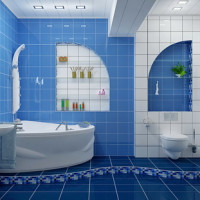 Do-it-yourself waterproofing in the bathroom: a comparative overview of materials + installation instruction
Do-it-yourself waterproofing in the bathroom: a comparative overview of materials + installation instruction 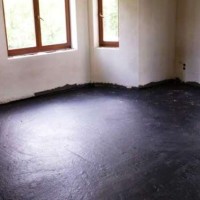 Waterproofing the floor in the apartment: features of the choice of insulation materials + work procedure
Waterproofing the floor in the apartment: features of the choice of insulation materials + work procedure 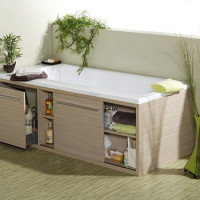 Bathroom Screens: Types, How to Choose the Right One, Which is Better and Why
Bathroom Screens: Types, How to Choose the Right One, Which is Better and Why 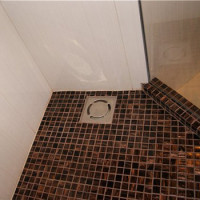 How to make a floor drain for a shower under a tile: a guide to construction and installation
How to make a floor drain for a shower under a tile: a guide to construction and installation 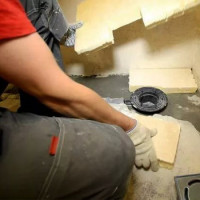 How to arrange a shower drain in the bathroom floor: step-by-step installation instructions
How to arrange a shower drain in the bathroom floor: step-by-step installation instructions 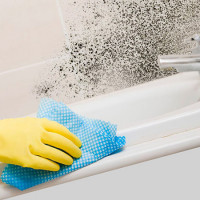 Black mold in the bathroom: how to get rid of a fungus + effective means to combat and prevent
Black mold in the bathroom: how to get rid of a fungus + effective means to combat and prevent  How much does it cost to connect gas to a private house: the price of organizing gas supply
How much does it cost to connect gas to a private house: the price of organizing gas supply  The best washing machines with dryer: model rating and customer tips
The best washing machines with dryer: model rating and customer tips  What is the color temperature of light and the nuances of choosing the temperature of the lamps to suit your needs
What is the color temperature of light and the nuances of choosing the temperature of the lamps to suit your needs  Replacement of a geyser in an apartment: replacement paperwork + basic norms and requirements
Replacement of a geyser in an apartment: replacement paperwork + basic norms and requirements
I have an apartment in Khrushchev, according to this layout, a window is provided in the wall between the bathroom and the kitchen. Soon I’m thinking of starting a major overhaul in the bathroom, during which I decided to get rid of this window.Is it possible to use moisture-proof drywall to close the specified window opening? Will the tile stay on it? If so, how is it better to protect it from moisture?
Hello. It will be easy to hold, nothing special to handle, a special primer to go before puttying and after it, before laying the tiles. The putty is moisture resistant.
Frankly, not everyone follows these waterproofing rules. I laid tiles on ordinary walls, which I leveled and primed. The primer took the most common. And the same thing with sex. Over the years of operation, no problems arose. And I don’t see what they could do if people had lived in my apartment for ten years, and the walls in the bathroom, like the floor, were simply painted with ordinary paint.
But how many problems? My husband is engaged in repairs and for 5 years working in this area, I have never done this, they always did with plaster, primer and tile on top and that's it. I also understand making insulation under the bath or shower, but why the whole room?
You can waterproof not the entire bathroom, but only important areas. But I do not recommend this. In the bathroom there are a lot of risks - leaking a washing machine or pipes, children splashed when they washed, even shed something.
Waterproofing is not very expensive, but very useful. Especially if your husband can do it yourself. There is nothing complicated there. Take waterproofing from Knauf, it does not require almost any preparation - opened a jar and smear the walls in 2-3 layers.